Irresistibly chewy, this sourdough ciabatta bread recipe has a deliciously addicting open crumb texture on the inside with a gently crisped outside. Dip in oil as an appetizer, or use this bread for your next sandwich lunch.
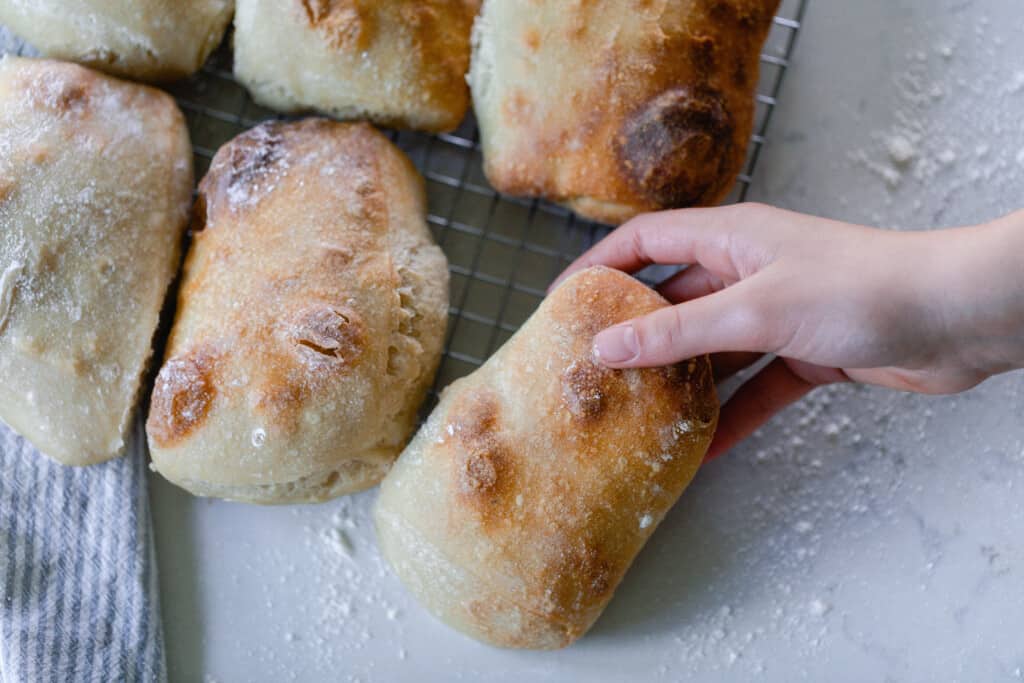
This recipe is so yummy. There is nothing like fresh baked bread, in my opinion.
There may be a little work in the beginning, but it is so worth it.
Honestly, this great recipe is really easy. You simply have to be patient as you painstakingly wait for the natural, wild yeast to do its magic.
I’ve come to love crafting and kneading artisan bread. Truly, there’s nothing like making real food with your own two hands.
As we continue to grow and cultivate our homestead, it’s truly a long-awaited dream come true.
Making homemade bread while staring out over the lush garden, with our white, 1800’s, antique barn – complete with chickens and cows foraging the land… there is truly nothing like it.
It’s a calming and breathtaking sight, and I’m thankful that after many years and many sacrifices (you can see how we paid off our house here and bought our new one with cash), we get to call our farm home.
Back to baking … Let’s make some delicious sourdough ciabatta bread.
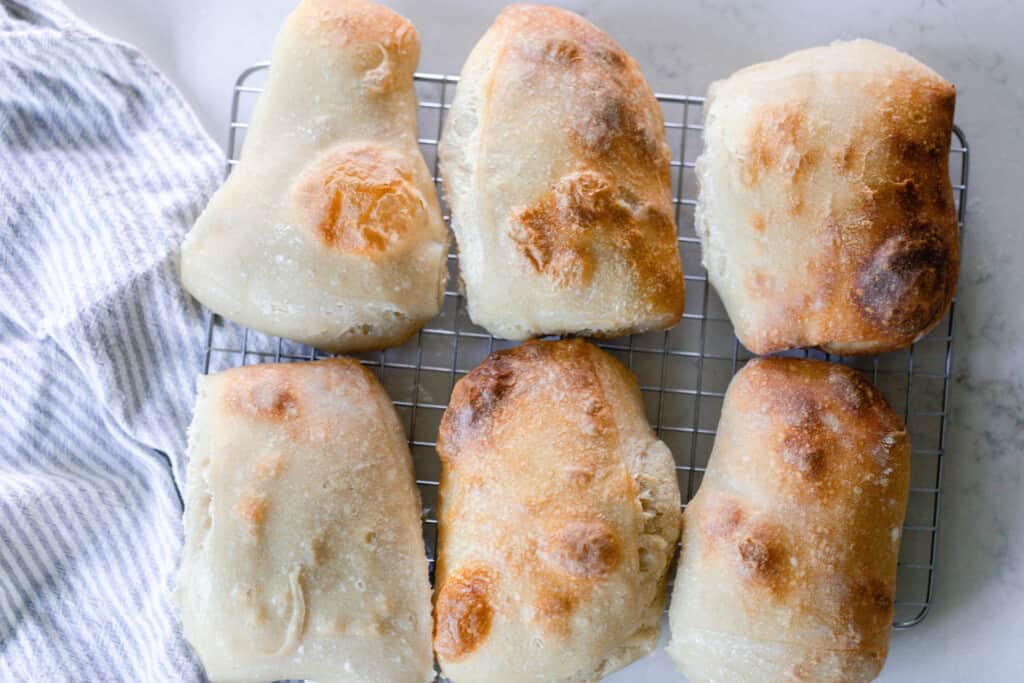
Tips:
- If you struggle with gluten sensitivity, try fermenting the dough for at least 12 hours. The longer fermentation time allows the wild yeast to break down the gluten more. Also, I would suggest dusting the top with einkorn flour during the last step before baking. Einkorn is much easier to digest than regular wheat.
- Using a stand mixer to knead the dough will make the process so much easier. You can hand-knead, but it will take about twice as long. Stretching and folding the dough is a great alternative, but requires you to be home during the first few hours of the process.
- Placing a cast iron skillet filled with water in the oven while the bread is baking will help keep enough moisture in the oven.
- If you want to use whole wheat in this recipe, I would suggest substituting up to 1/2 of the all-purpose flour for whole wheat flour.
FAQ:
What makes ciabatta bread different?
It is a fermented Italian bread that develops a chewy texture. Ciabatta means “slipper”, deriving from the process of forming and baking two loaves without a mold or bread pan.
Is ciabatta bread healthy?
We love sourdough in our house, and for good reason (you can learn how to make a sourdough starter here). This ciabatta bread is a great and healthy way to eat grains.
Basically, the phytic acid that is found in grains, beans, and nuts is an anti-nutrient that interferes with the absorption of certain nutrients. Phytic acid is present on grains to keep them from spoiling.
The evidence presents that our bodies weren’t meant to handle them.
Proper preparation of grains, like fermentation with sourdough, eliminates much of the phytic acid that is present and makes them more digestible.
Many people that can’t tolerate regular grains can tolerate long-fermented grains.
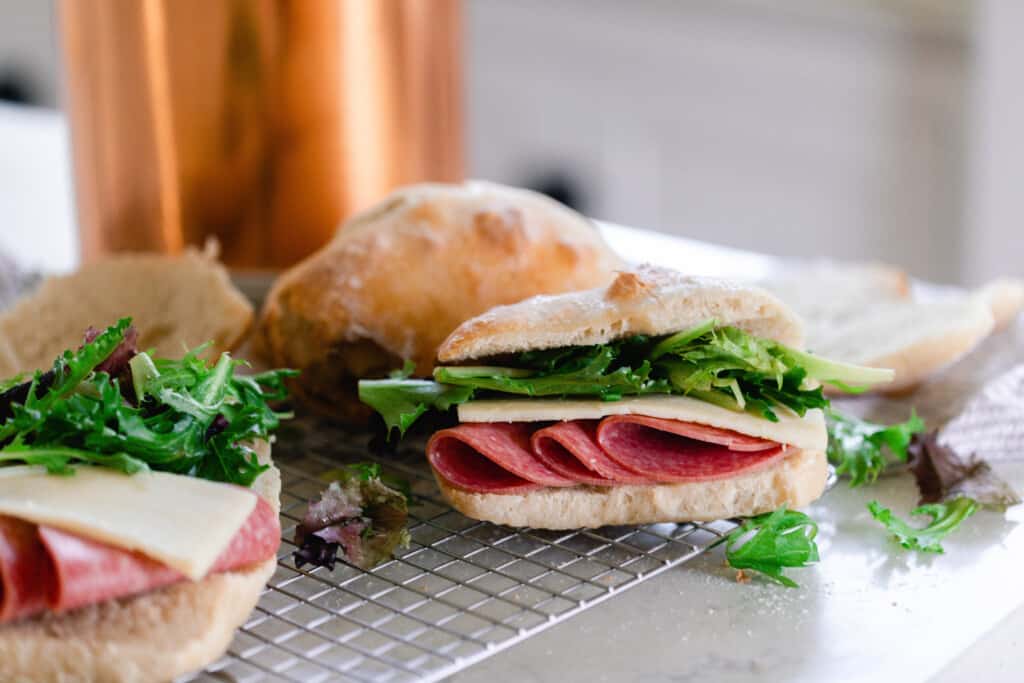
What do you eat ciabatta bread with?
This is the perfect bread for sandwiches. Alternatively, you can serve it with a small dish of olive oil, Parmesan, salt and pepper for dipping.
How do you shape ciabatta?
After the bulk refrigerator ferment, gently flatten the dough into a rectangle. Be careful not to deflate any of those beautiful bubbles. Use a bench scraper, or sharp knife, to cut the dough down the middle and then into four equal sections on both halves. You don’t need to worry about this being too precise! I love the rustic quality of homemade sourdough ciabatta.
This post contains affiliate links, which means I make a small commission at no extra cost to you. See my full disclosure here.
Tools you may need:
Baking stone: (You could also use a sheet pan if you don’t have a pizza stone.)
Parchment paper or baker’s couches
Large bowl
Bench scraper (optional)
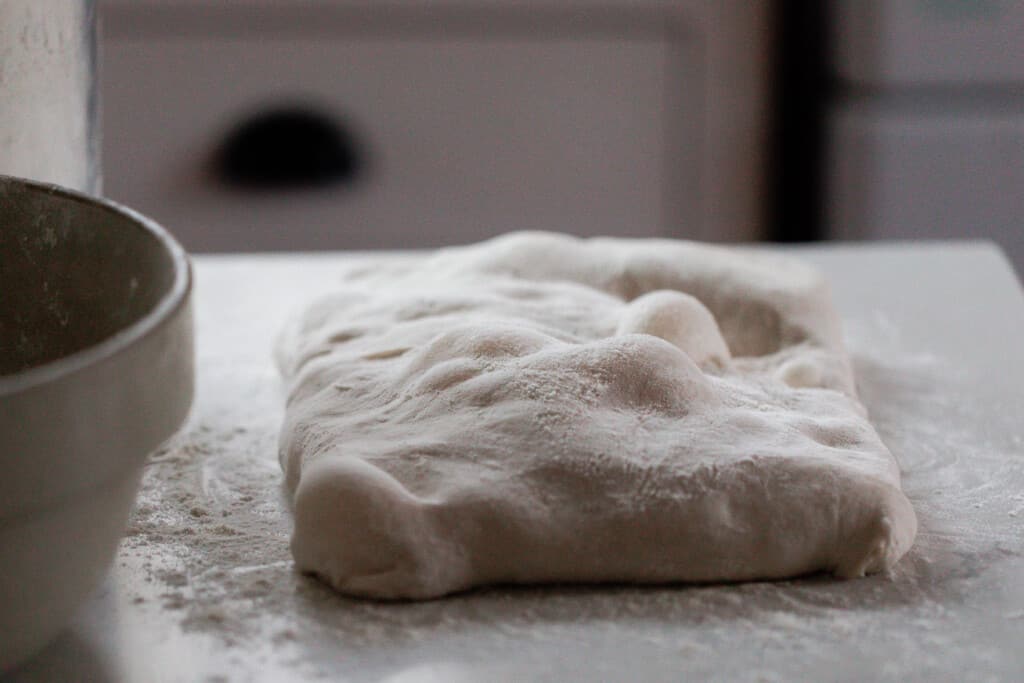
Sourdough Ciabatta Ingredients:
Active sourdough starter – Also known as a ripe sourdough starter. This is sourdough starter that has been fed within 4-12 hours, has about doubled in size, and is nice and bubbly. I use a 100% hydration starter.
Room temperature water – Preferably filtered. Chlorine in water may inhibit the natural yeasts.
Salt
Bread flour – I prefer to use bread flour for this recipe, but regular ol’ white flour works perfectly fine as well. It can hold the structure to give those nice big holes.
How to Make Sourdough Ciabatta Bread
Feed sourdough starter 4-12 hours before starting the sourdough ciabatta dough.
Stretch and fold method
This is my preferred method, especially if I am going to be home to tend to it.
Gently combine the starter, water, salt and flour in a large mixing bowl. Allow the dough to rest for 30 minutes to autolyse.
Perform three series of stretch and folds each 30 minutes apart. (Make sure to cover the bowl with plastic wrap, foil, or a damp tea towel in between so the dough doesn’t dry out.)
To do this, first stretch the dough up about 6 -12 inches on one side, and then push it in to the center of the dough. Turn the bowl a quarter turn, and repeat the process, turn a quarter turn, repeat the stretch and fold.
Kneading method
Add starter, water, salt, and flour to a stand mixer.
Knead for about 10 minutes or so on the medium setting until the windowpane test is passed. It should be a smooth and elastic dough. This is a high hydration dough (aka its a sticky dough) and should be really stretchy when proper gluten development has happened.
The first rise
Cover the bowl with a damp tea towel, and allow it to rise until doubled. The time this takes will depend on the temperature of your house and how active your starter is. For me, this usually takes about 4 hours.
Bulk Fermentation
Transfer the dough to the refrigerator and allow it to ferment for 12-24 hours.
The next day, slide the dough out of the bowl and onto a floured work surface. Be careful not to deflate the bubbles.
Gently shape the dough into a rectangular shape, and dust the top with flour
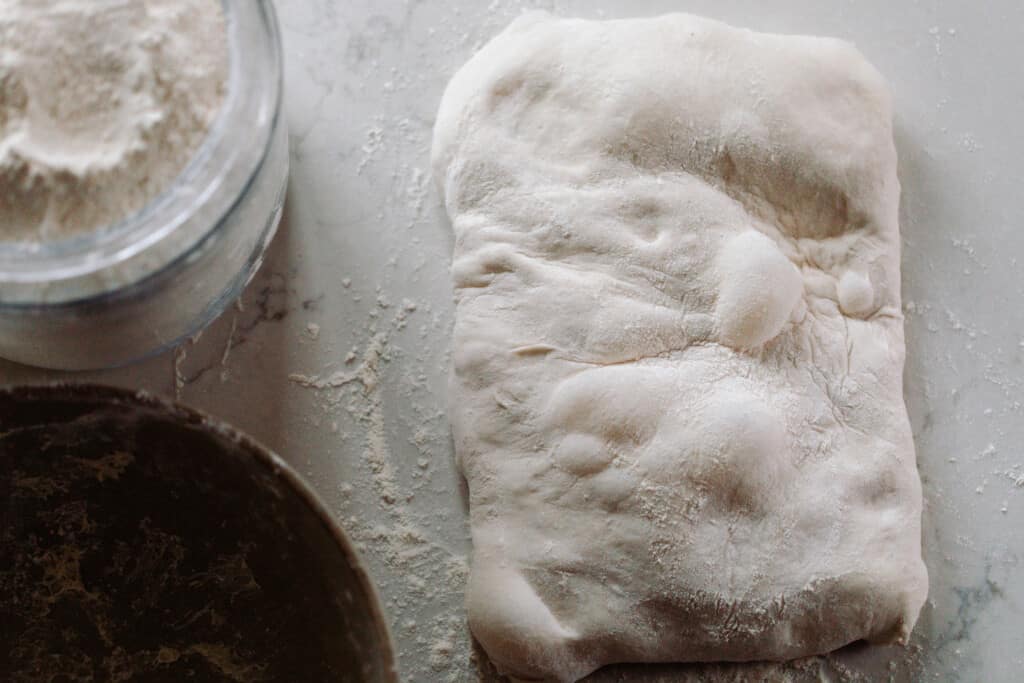
Divide the dough into 8 equal pieces by cutting it down the middle lengthwise and then making three cuts on each side.
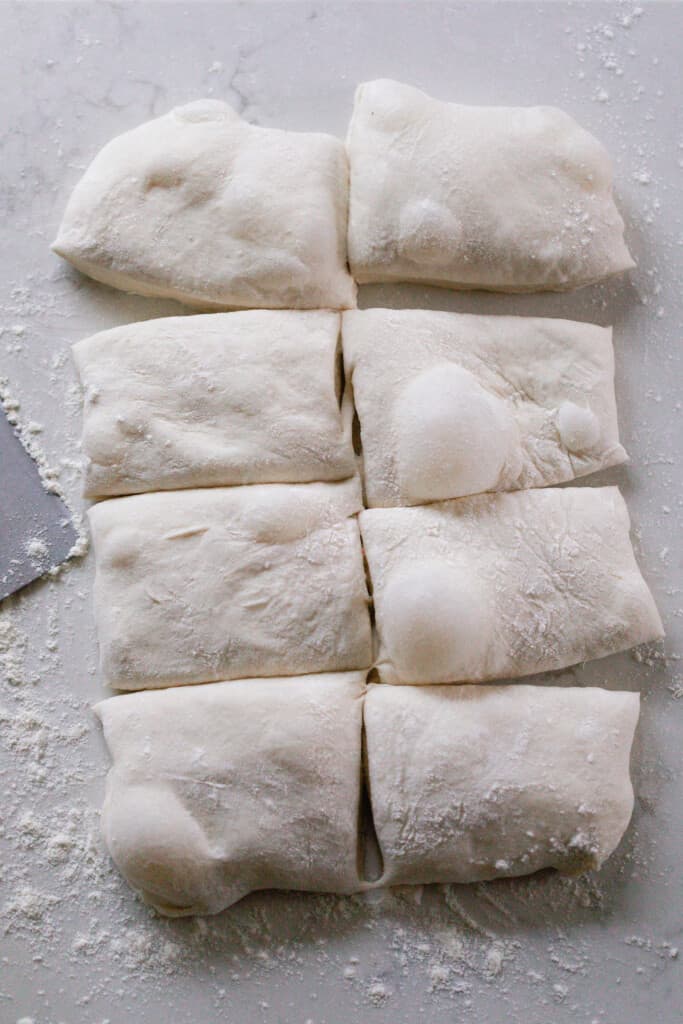
Use the bench scraper to gently transfer the rolls to parchment paper.
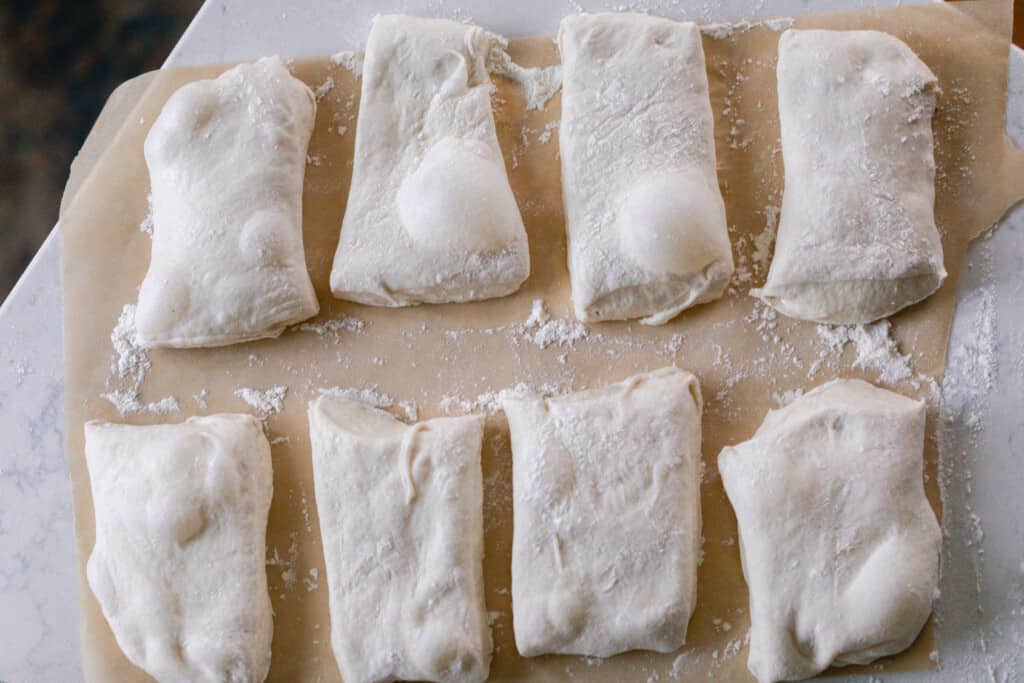
Cover with a tea towel and allow to rise 1-2 hours.
Baking Sourdough Ciabatta
Preheat pizza stone at 475 and put a cast iron skillet on the bottom rack.
Add a bit of water to the cast iron skillet on the bottom rack for steam (this helps the crust to develop a golden color and give it an extra-crusty crust).
Slide the loaves onto the pizza stone (with the parchment paper) or a large baking sheet, and place into the hot oven.
Bake for 25 minutes or until the crust is golden.
Move to a cooling rack to cool.
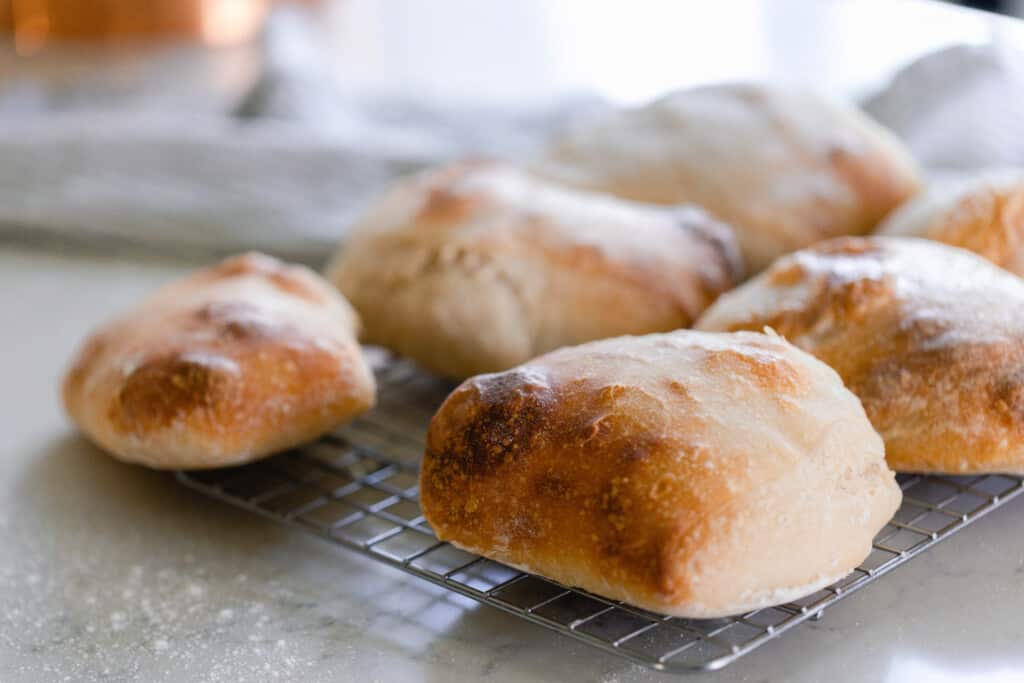
Storage:
Store fresh loaves in a paper bag or a thin tea towel. Once cut, store in an airtight container. They also freezes incredibly well.
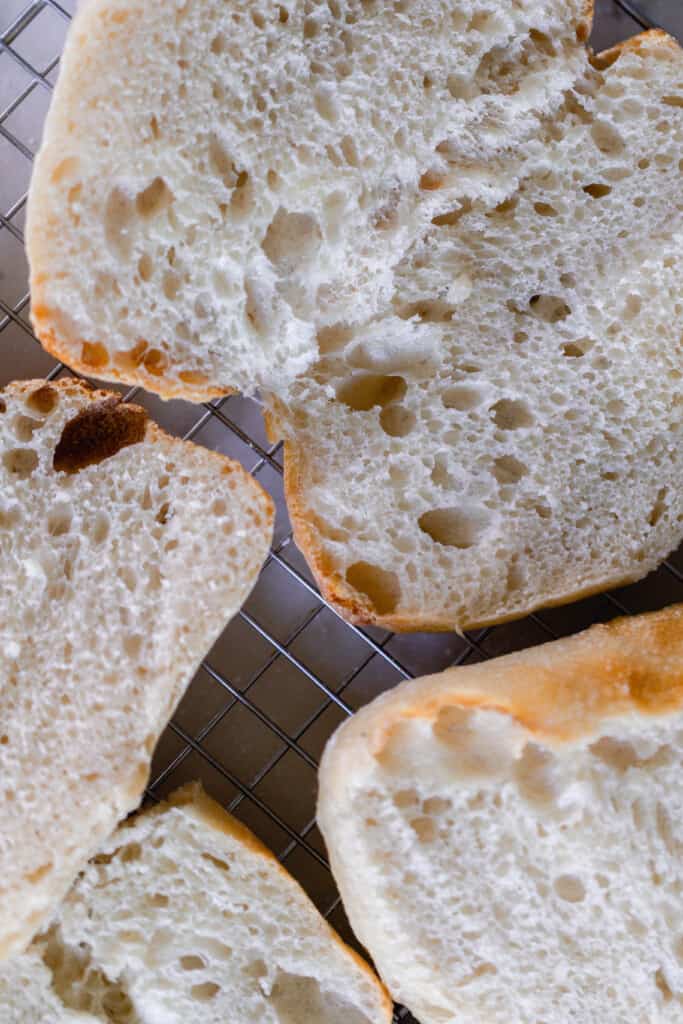
Baker’s Schedule:
8 am: Feed sourdough starter with flour and water. Depending on how active your sourdough starter is, it could take between 4-12 hours for it to be active enough to bake a loaf of bread.
4 pm: If the sourdough starter is nice and bubbly, then proceed to creating the dough.
Cover with a lid or plastic wrap and allow the dough to rise until doubled.
8 pm: Place the covered bowl in the refrigerator.
The Next Day
8:00 am (may be sooner or later): Turn the dough out onto a flour surface and cut into eight equal pieces.
Dust the top of the dough with flour. Allow to rise 1-2 hours.
10:00 am: Preheat the oven to 475. Then bake.
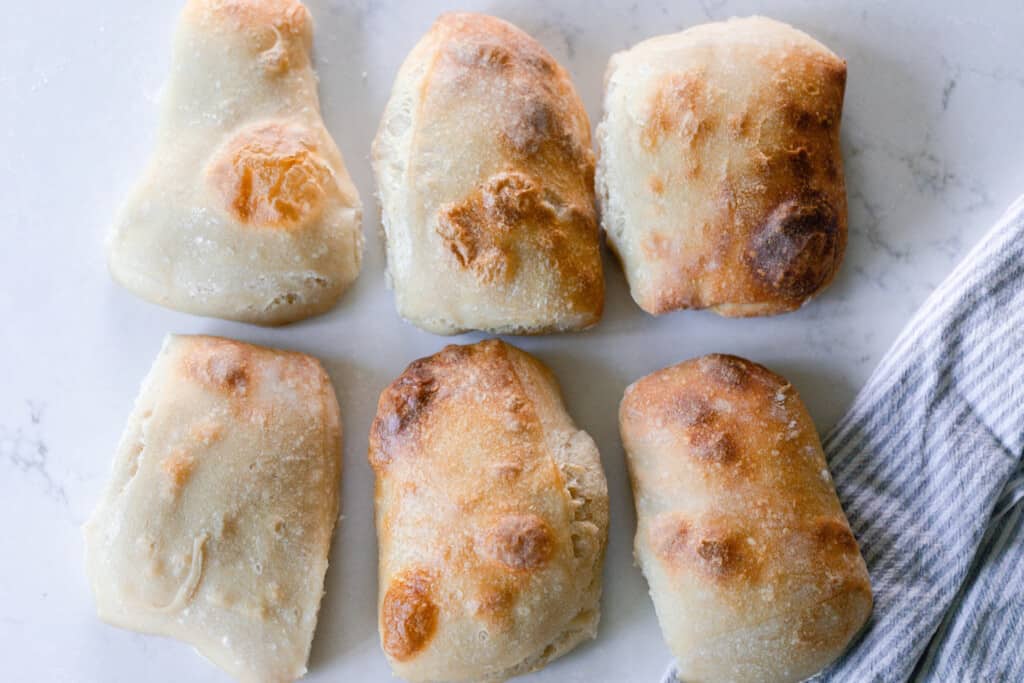
Find More Sourdough Bread Recipes:
- Sourdough Potato Bread
- Sourdough Chocolate Bread
- Rosemary Sourdough Bread Recipe
- Sourdough Brioche
- No-Knead Sourdough Bread
If you make this recipe and love it, I would love if you gave it 5 stars! Tag me on Instagram @farmhouseonboone with your delicious creation.
Sourdough Ciabatta

Ingredients
- 1 cup bubbly and active sourdough starter, 227 grams
- 2 cups water, 472 grams
- 1 tablespoon salt, 17 grams
- 4 ½ cups bread flour, 630 grams
Instructions
- Feed sourdough starter 4-12 hours before starting the sourdough ciabatta dough.
- Gently combine the starter, water, salt and flour in a large mixing bowl. Allow the dough to rest for 30 minutes to autolyse.
- Perform three series of stretch and folds each 30 minutes apart. (Make sure to cover the bowl with plastic wrap, foil, or a damp tea towel in between so the dough doesn’t dry out.)
- To do this, first stretch the dough up about 6 -12 inches on one side, and then push it in to the center of the dough. Turn the bowl a quarter turn, and repeat the process, turn a quarter turn, repeat the stretch and fold.
- Cover the bowl with a damp tea towel, and allow it to rise until doubled. The time this takes will depend on the temperature of your house and how active your starter is. For me, this usually takes about 4 hours.
- Transfer the dough to the refrigerator and allow it to ferment for 12-24 hours.
- The next day, slide the dough out of the bowl and onto a floured work surface. Be careful not to deflate the bubbles.
- Gently shape the dough into a rectangular shape, and dust the top with flour.
- Divide the dough into 8 equal pieces by cutting it down the middle lengthwise and then making three cuts on each side.
- Use the bench scraper to gently transfer the rolls to parchment paper.
- Cover with a tea towel and allow to rise 1-2 hours.
- Preheat pizza stone at 475 and put a cast iron skillet on the bottom rack.
- Add a bit of water to the cast iron skillet on the bottom rack for steam (this helps the crust to develop a golden color and give it an extra-crusty crust).
- Slide the loaves onto the pizza stone (with the parchment paper) or a large baking sheet, and place into the hot oven.
- Bake for 25 minutes or until the crust is golden.
- Move to a cooling rack to cool.
Notes
- If you struggle with gluten sensitivity, try fermenting the dough for at least 12 hours. The longer fermentation time allows the wild yeast to break down the gluten more. Also, I would suggest dusting the top with einkorn flour during the last step before baking. Einkorn is much easier to digest than regular wheat.
Nutrition
Nutrition information is automatically calculated, so should only be used as an approximation.










Easy recipe to follow. I have baked ciabatta before, this is the first time with the starter I purchased at Amazon. I am anxious to see the difference. I like to experiment.
Delicious! These are crunchy on the outside and soft and chewy on the inside. Love the Costco ones but these are even better! Just delicious!
We’re always buying ciabatta from Costco, but these are much better! Follow the directions and you’ll have no problem
This is pretty much the only bread that i make anymore. Family and friends love it. Fun to make and forgiving in my opinion. I do my fold and turns in between other daily tasks and it all always turns out great. I’ve experimented with using a bit of whole wheat dough and that didn’t turn out that great(still very, very edible) but every iteration using the listed proportions (weighted out) has turned out great.
I doubled the recipe and I did not put enough starter in because I was using your gram measurement which does not change from 227 g. I don’t know if it will turn out. You may consider having the grams change with the 2x and 3x recipes.
The same just happened to me. I would not have realized it if I had not read your comment! I clicked on double the recipe, but only went by the weight. I didn’t actually double the recipe like I thought!
Hi,
I’ve made this multiple times and they are always very tasty. The only issue I have is that the crust (outer layer?) on top is very chewy and stretchy. The bottom seems fine. Would you have any recommendations on getting it a bit crispier? Things I’ve tried
1. Spraying the dough with water before baking
2. Additionally, I’ve put a cast iron skillet with water at the bottom of the oven to build steam. However, I feel like this steam is mostly vented out when I open the oven door to load the dough. Steam builds up again though.
3. Covering the loaves with a bake pan after spraying with water (for 10mins of the bake) to trap some steam.
4. Reducing the hydration (as I live in a high humidity area) to see if it makes a difference on the crust.
Thanks
Wonderful ciabatta! I love the crispy crust and soft insides. I use these rolls in place of all others. Easy to follow recipe. Thank you!
I’ve made this once before- amazing! Everyone loved it. If I need to DOUBLE the recipe. Should I do it in one batch or two separate batches for the rise/fermentation and all that?